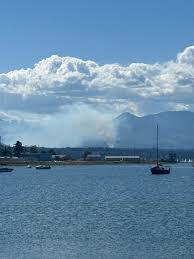Raging Flames: The Comox Lake Fire Unfolds
This summer, the picturesque Comox Valley has faced an alarming reality—wildfires. The start of the Comox Lake fire, which ignited earlier in July, has brought unprecedented challenges to local emergency services and ignited a sense of urgency among residents.
A Closer Look at the Incident
Initial reports indicate that the Comox Lake fire began on July 12, sparked by a combination of dry conditions and strong winds that swept across the region. By mid-August, firefighting crews had battled the flames, which quickly expanded beyond initial containment lines, bolstered by shifting weather patterns that fanned its growth.
The British Columbia Wildfire Service (BCWS) categorized the Comox Lake fire as a Class 3 blaze, a classification that denotes a significant threat to communities and wildlife. By mid-August, almost 1,500 hectares had burned, prompting evacuations in nearby areas.
Community Impact and Response
The fire’s impact extends well beyond immediate evacuation orders. Residents have expressed a mixture of fear and resilience. Local businesses have suffered as people flocked to safety, leaving them uncertain of how they will recover. “It’s nothing short of devastating. We’re a small community, and everyone feels the pinch when a disaster strikes like this,” commented local shop owner Emma Richards.
In response to the crisis, the Comox Valley Regional District established an emergency operations center, coordinating shelters for evacuees and distributing essential supplies. Social media has played a vital role in keeping residents informed, with hashtags like #ComoxLakeFire trending as citizens shared updates, resources, and emotional support.
Expert Perspectives
Wildfire experts have voiced concerns about the long-term implications of the Comox Lake fire. Dr. Mark Theroux, a wildfire management researcher at the University of British Columbia, explained, “The increasing frequency and intensity of wildfires in this region are linked to climate change. This is part of a larger pattern we need to address moving forward. Effective management requires both community preparedness and environmental stewardship.”
Looking Ahead: Recovery and Preparedness
As firefighting crews continue their arduous efforts to contain the Comox Lake fire, the community is already turning its attention toward recovery. Plans for reforestation and rebuilding the devastated areas are underway. There is an increasing acknowledgment that residents must adapt to more frequent fire events—emphasizing the importance of establishing fire breaks, improving infrastructure, and enhancing early warning systems.
While the prognosis for recovery is hopeful, experts warn that the fight against wildfires in British Columbia has just begun. With unpredictable weather patterns and ongoing environmental stressors, preparing for future fires has never been more critical.
In Summary
The Comox Lake fire serves as a stark reminder of the evolving climate and the need for sustainable practices in our interactions with the land. But amid the ashes, the resilience of the Comox Valley community shines through, highlighting their strength as they face the challenges ahead.

